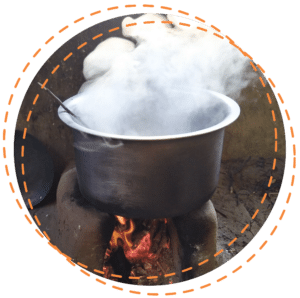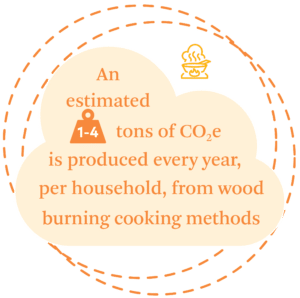
What are improved cookstove carbon projects?
Improved cookstove carbon projects are intended to reduce greenhouse gas (GHG) emissions and improve the overall environmental and human health impacts of common cooking practices, particularly in developing countries.
Often, cooking methods in undeveloped regions involve open fires or basic stoves that burn solid fuels like wood, crop residues, charcoal, or other biomass. These cooking fuels release significant amounts of carbon dioxide (CO2) and other pollutants into the atmosphere, contributing to deforestation, air pollution, and respiratory health issues. Improved cookstove carbon projects focus on introducing and promoting the use of more efficient and cleaner cooking technologies, commonly referred to as “improved clean cookstoves”.
How do improved cookstoves work?
- Identification The initial step is to identify communities or regions where advanced cooking techniques would significantly improve emissions reductions and the general well-being of the population. This process involves looking at a combination of factors, including areas that are prone to use open-fire cooking, areas with a history of deforestation, communities with a higher volume of health problems caused by indoor air quality, and general community engagement.
- Engagement, Distribution, and Education Once local communities are identified, it is critical for the project stakeholders to become engaged with the residents to help educate them about the benefits of the cookstoves and encourage long-term utilization. The engagement comes in the form of local partnerships, community workshops, demonstrations, and training programs.
- Monitoring Prior to distribution, a baseline is set which acts as the reference point for measuring emission reductions. Ongoing monitoring and data collection practices are put in place to track improved stove utilization and measure long-term emissions reductions.
- Crediting The emissions reduced from the project are then quantified into carbon credits, measured in CO2 metric ton equivalent. The revenue generated from the sale of these credits is typically used to finance additional projects or to provide continued education to the local communities.
What are the benefits of improved cookstove carbon projects?
Environmental
- Advanced cookstove carbon offset projects promote biodiversity and decrease the rate of deforestation by eliminating the need for wood or other biomass for cooking.
- Advanced cookstoves burn fuel more efficiently, resulting in lower GHG emissions, particularly carbon dioxide (CO2) and methane (CH4).
Social
- Oftentimes, jobs are created for the local community members to help with the distribution and education of the cookstove operation and its benefits.
- Cookstove projects support women’s empowerment by giving them access to clean household cooking solutions, significantly reducing the time spent collecting fuel. With less time spent gathering biomass, beneficiaries have a greater opportunity to generate income and enjoy other activities.
Health and Safety
- By improving cooking techniques, advanced cookstove projects lead to better indoor air quality, and reduce long-term health problems related to indoor air pollution, such as respiratory illness, especially among women and children who spend considerable time near the cooking area.
- Advanced cookstoves are built with significantly safer designs compared to open-flame cooking, reducing the risk of injury or household fires.
By the numbers:
- In 2020, 2.4 billion people worldwide cooked with traditional polluting fuels and technologies.
- It is estimated that an equivalent of 1-4 tons of CO2, or roughly 2-3% of global GHG emissions, is produced every year, per household, from wood-burning cooking methods.
- Improved cookstoves can reduce fuel consumption by 40-60%.
- Globally, over 15% of ambient air pollution comes from household air pollution.
- Improved cookstoves can reduce indoor air pollution by up to 90%, resulting in fewer respiratory illnesses and health-related issues.
- 50% of the world’s wood is harvested for use as a fuel source, and 30% of that is estimated to come from unsustainable sources.
- Improved cookstove projects align with several of the United Nations’ Sustainable Development Goals (SDGs), including those related to health and well-being (SDG 3), gender equality (SDG 5), affordable and clean energy (SDG 7), and climate action (SDG 13).
View other project profiles or contact us.



